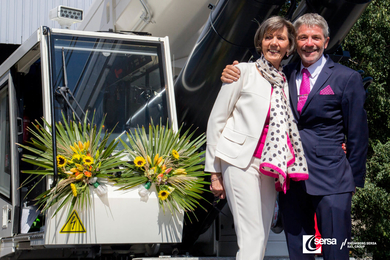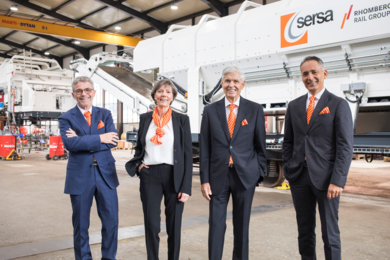A look at the cooperation between Rhomberg and Sersa, as recounted by Robert Kumpusch, Member of the Management Board at Rhomberg Bahntechnik; responsible for RSRG project business with the core competencies of slab track, rail technology equipment and railway tunnel rehabilitation. With the company since 2003, with the exception of 2012-2015.
I clearly remember when I was appointed Managing Director for mechanised track construction at Sersa at the end of 2016. My colleagues' thoughts were probably something along the lines of: “Now an Austrian wants to come and tell us Swiss how track construction works.” At the Christmas party, Konrad Schnyder spoke very kindly about me and basically explained it to his team like this: “He also has skills and will bring something to the table.” I haven’t forgotten that.
Friction necessary to achieve mutual understanding
Both companies were challenged in the Albis Tunnel project in Switzerland in 2015. Sersa’s technical competence and Rhomberg’s project management were needed in equal measure. Of course, the mutual understanding did not exist in the beginning. Friction was inevitable. It quickly became clear that our task was to focus on interaction. To make joint successes visible in a targeted manner, to lay topics on the table openly, not to make assumptions and instead to let facts do the talking, to generate pride in what we achieved together. It was important to acknowledge in the group that we could not lose ourselves in stubbornness and in the insistence on being right, but that it was a matter of “this is OUR path”. Today, the mutual understanding is already very pronounced. The employees recognised that they needed one another to meet the growing demands of our clients.
Combined expertise creates added value
The Rhomberg Sersa Group possesses a high level of expertise in the specialised units. In the course of time, we have learnt that we can become even better if we combine the different types of expertise. An example from Switzerland: Today, we commission and transfer track-laying machines internally, with our own expertise, and are therefore faster and more flexible than with external procurement. Another example from our current operations: When installing switches in Stuttgart, the project team is provided with support from Sersa experts in the initial phase, which helps enormously.
Characteristics of the Rhomberg Sersa Group
From today’s perspective, I would describe the group’s character as follows: Thoughtful, motivated, traditional, and nonetheless open to new things, not yet endlessly homogeneous. Our culture today is shaped by collaboration; everyone can talk to everyone and make things happen, as we have a flat hierarchical structure. Discussions to find out whether new ideas makes sense are never dismissed or turned away, because everyone wants the organisation to go forward. Even today, people from my time in mechanised track construction contact me and ask for advice or support. For me, those are highlights; I regard it as proof of trust and respect.
Vision for 2032
In 2032, we are working together in an innovative and cooperative way. Our high level of transparency creates trust. Each unit is autonomous. The question “Do we want to work together, does it make sense for both?” is crucial for jobs that we do jointly. That also applies to collaborating with partners and clients. Cooperation is the answer to increased complexity; this is the only way in which we can solve all our challenges. We work in novel cooperation models, including as far as contracts are concerned. Our success can be felt in the fact that we have good projects, good people, we are moving things forward, and completing projects makes sense and is fun - for everyone personally and for the company. We are enjoying our work in 2032.








